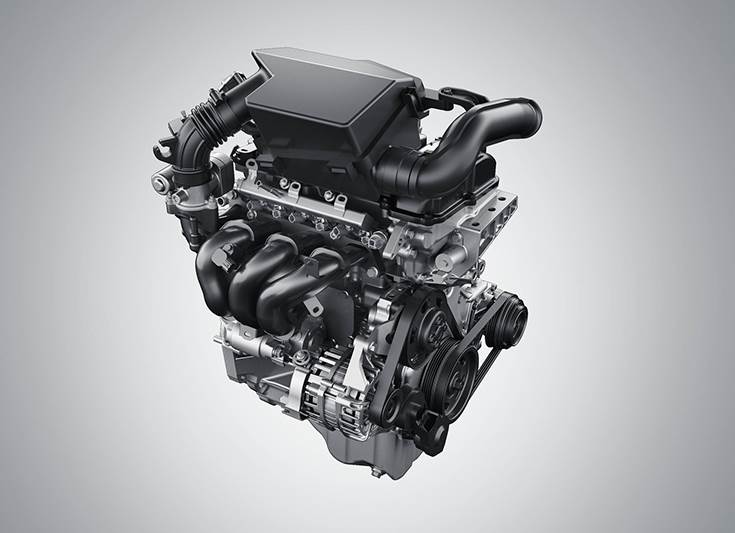Passenger vehicle market leader has launched the 2022 Model Year Alto K10 entry level hatchback with prices ranging from Rs 399,000 to Rs 584,000 (ex-showroom Delhi).
The 2022 Alto K10 is larger than its predecessor – 3530mm long, 1490mm wide and 1520mm tall. The new Alto K10 is 85mm longer and 45mm taller than the Alto 800. While the wheelbase is also bigger by 20mm at 2380mm, the width remains common to the Alto 800.
The new Alto K10 gets substantial styling updates, both in front and rear. The small Maruti now is more rounded albeit a tad more upright than its predecessor. On the side, the car gets a prominent shoulder line and a few more character lines. Like the Celerio, the new Alto K10 gets lift-up door handles. As standard, the Alto K10 rides on 13-inch steel wheels with plastic wheel covers.
The rear end design, however, is rather plain and at first glance looks very similar to that of the Celerio. On closer look, however, you’ll notice that the tail-lights are slightly different, and the rear bumper mimics the front one’s design. Like its predecessor, it still misses out on a rear wash/wiper.
High on fuel efficiency
The third-generation Alto K10, which is based on Suzuki’s Heartect platform that underpins a number of Maruti Suzuki models, is powered by the carmaker’s new 1.0-litre K10C petrol engine that develops 67hp and 89 Nm torque (same as in the Celerio and S-Presso). Empowered by dual-jet technology and an idle start-stop system, the new Alto K10 improves on the fuel efficiency front, stretching every litre of petrol to 24.39kpl (5-speed manual) and 24.90kpl (5-speed automatic).

Dual-jet tech and an idle start-stop system help new Alto K10 stretch every litre of petrol to 24.39kpl (5-speed manual) and 24.90kpl (5-speed automatic).
Given the sustained demand for CNG-powered Maruti cars, a CNG variant equipped with the 1.0-litre K10C engine is expected to be offered on the new Alto in the future.
Fully redesigned interior
The new Alto K10’s interior gets an all-black interior theme while a new 7.0-inch touchscreen infotainment system – same as the Celerio, S-Presso – garnished with two silver accents on either side is the mainstay of the dashboard.
The central AC vents mimic the design of the pre-facelift second-gen Alto, while a lot of the switchgear such as the steering wheel, control stalks, interior door handles and side AC vents have been lifted from the Celerio. The digital instrument cluster is, however, unique to the Alto.

In terms of features, the new Alto K10 gets manual air-conditioning, a 7-inch Smart Play infotainment system with Apple CarPlay and Android Auto, steering mounted controls, digital speedometre and a four-speaker audio system. On the safety front, the hatchback gets ABS, dual front airbags and front seatbelt pretensioners. Maruti is also offering two accessory packages – Glinto and Impacto. Both accessory packages bring several exterior cosmetic updates with the former focused on chrome while the latter gets contrast orange accents.
Maruti bullish on new Alto K10’s market potential
In India’s PV market, half of which now belongs to SUVs, entry-level hatchbacks are seeing demand slowing, particularly in the wake of the pandemic which left the bottom end of the pyramid impacted adversely. At the affordable end of the hatchback market, the new Alto K10 has the Renault Kwid as its main rival along with its sibling the Alto 800 (Rs 339,000 to Rs 503,000) andf the S-Presso (Rs 425,000 to RS 599,000).
However, Maruti Suzuki’s Shashank Srivastava is confident about the new Alto K10’s potential. He says, “Close to half of PV customers are first-time car buyers in India. Despite the growing demand for SUVs, Maruti Suzuki commands an over 68% share of the hatchback segment.”
He adds, “With 66% of India’s population being less than 35 years of age, the hatchback segment is well poised to witness growth as this population enters the workforce in the coming years. Alto consumers have evolved rapidly over the last few years and now expect more from the brand. The entry-level consumers no longer want to settle for affordability alone, and seek more even if it warrants paying slightly extra.”
(With inputs from Maank Dhingra)
/news-national/maruti-suzuki-launches-new-alto-k10-at-rs-399-000-92545 Maruti Suzuki launches new Alto K10 at Rs 399,000 Redesigned inside and out, the high-on-fuel efficiency entry level hatchback looks to draw buyers across town and country. https://www.autocarpro.in/Utils/ImageResizer.ashx?n=http://img.haymarketsac.in/autocarpro/3c058c5c-17ea-43bb-8507-7a85f923c6eb.jpg
